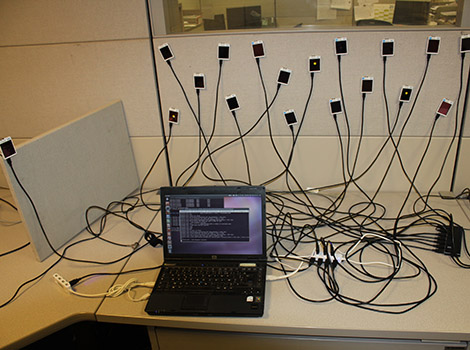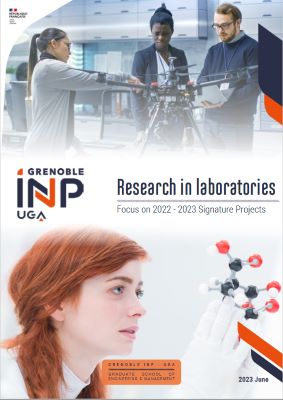Once data has been measured, it must be transmitted. Connected objects only need to exchange very little data for a large number of applications.
The researchers at LIG have set up an 802.15.4-type network of nodes that communicate by radio (ZigBee). They are also studying the possibility of communicating via Bluetooth, or via Wi-Fi variants suited to these low consumption sensor nodes. However, there are companies (including telephone operators) that are currently in the process of developing communication networks that are especially suited to this use. Accordingly, the Toulouse start-up SIGFOX, co-founded and managed by Ludovic le Moan, a graduate of Grenoble INP - Ensimag, is working on a very low speed national network with an ultra-narrow ultra-frequency band, to exchange information between sensors and a base station for example.
Several experimental projects
A concrete example of a communicating object is Linky, the electric meter created by ERDF. Linky has the features of a conventional meter (sensor) but it is also able to use PLC to send information via the low-voltage network to a data concentrator. The data is then sent by radio to the distributor’s central information system. Linky is the key element of several experimental Smart Grid projects such as SOGRID and GREENLYS, in which Grenoble INP is involved (G2ELab, LIG) alongside its industrial partners (ERDF, GEG, GDFSUEZ, Schneider Electric, Atos World Grid et Alstom Grid). Of course, the ever increasing number of connected objects will generate enormous quantities of data that are the source of Big Data. Therefore, the question is how can we validate data accuracy, manage storage, information processing, sharing and above all, the safety of data? LIG, TIMA and Verimag are all working on these aspects. TIMA is developing encryption algorithms to secure data and some of Verimag’s work is geared towards guaranteeing data confidentiality and the integrity of the packages exchanged. An experimental platform has been set up at Grenoble INP in order to implement and test the sensors in actual conditions: some rooms have been equipped with temperature and brightness sensors that communicate with each other and send information to a central monitoring system in real time. This open platform is also used as part of the Amiqual4home laboratory of excellence (labex), that seeks to catalyse research and innovation in smart software and systems in the Grenoble – Ise?re region by inventing, refining and experimenting new technologies to improve the quality of daily life, in particular home management.

The researchers at LIG have set up an 802.15.4-type network of nodes that communicate by radio (ZigBee). They are also studying the possibility of communicating via Bluetooth, or via Wi-Fi variants suited to these low consumption sensor nodes. However, there are companies (including telephone operators) that are currently in the process of developing communication networks that are especially suited to this use. Accordingly, the Toulouse start-up SIGFOX, co-founded and managed by Ludovic le Moan, a graduate of Grenoble INP - Ensimag, is working on a very low speed national network with an ultra-narrow ultra-frequency band, to exchange information between sensors and a base station for example.
Several experimental projects
A concrete example of a communicating object is Linky, the electric meter created by ERDF. Linky has the features of a conventional meter (sensor) but it is also able to use PLC to send information via the low-voltage network to a data concentrator. The data is then sent by radio to the distributor’s central information system. Linky is the key element of several experimental Smart Grid projects such as SOGRID and GREENLYS, in which Grenoble INP is involved (G2ELab, LIG) alongside its industrial partners (ERDF, GEG, GDFSUEZ, Schneider Electric, Atos World Grid et Alstom Grid). Of course, the ever increasing number of connected objects will generate enormous quantities of data that are the source of Big Data. Therefore, the question is how can we validate data accuracy, manage storage, information processing, sharing and above all, the safety of data? LIG, TIMA and Verimag are all working on these aspects. TIMA is developing encryption algorithms to secure data and some of Verimag’s work is geared towards guaranteeing data confidentiality and the integrity of the packages exchanged. An experimental platform has been set up at Grenoble INP in order to implement and test the sensors in actual conditions: some rooms have been equipped with temperature and brightness sensors that communicate with each other and send information to a central monitoring system in real time. This open platform is also used as part of the Amiqual4home laboratory of excellence (labex), that seeks to catalyse research and innovation in smart software and systems in the Grenoble – Ise?re region by inventing, refining and experimenting new technologies to improve the quality of daily life, in particular home management.

SUMMARY
- Connected objects - an everyday feature
- Welcome to the age of communicating objects
- Towards energy-independent objects
- Specific communication networks
- EnerBee develops energy-independent sensors
- GIPSA-lab’s embedded sensors
- SIGFOX implements the first international network dedicated to the Internet of Things and to machine-to-machine communications





